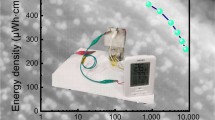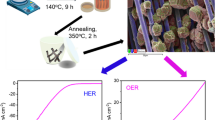Abstract
In this work, hydrophobic carbon cloth (HCC) was chemically activated by the facile oxidation method using a mixture of concentrated acid (H2SO4:HNO3) followed by ammonium hydroxide (NH4OH) treatment to make it a suitable electrode/current collector for energy storage device. It was found that the treated carbon cloth (TCC) turned hydrophilic by this treatment and a decrease in contact angle from 145.46 ± 0.28° to 72.93 ± 1.32° was observed. Fourier transform infrared spectroscopy (FTIR) confirmed the functionalization of TCC with C = O, O–H functional group. Brunauer–Emmett–Teller (BET) results showed the enhancement of surface area in TCC by 18 times. Field emission gun-scanning electron microscopy (FEG-SEM) and scanning probe microscope (SPM) analysis confirmed surface modification in TCC. The electrochemical properties of TCC were investigated using cyclic voltammetry (CV), constant current charge–discharge (CCCD) and electrochemical impedance spectroscopy (EIS). The areal capacitance of the TCC measured by CCCD was 908 mF cm−2 at 1.5 mA cm−2 in 1 M H2SO4 aqueous electrolyte. Specific capacitance retention rate was 95.02% after 5000 cycles at current density of 10 mA cm−2, and EIS study of TCC showed the charge-transfer resistance of 0.34 Ω.







Similar content being viewed by others
References
Murugan, R.; Ravi, G.; Vijayaprasath, G.; Rajendran, S.; Thaiyan, M.; Nallappan, M.; Gopalan, M.; Hayakawa, Y.: Ni-CeO2 spherical nanostructures for magnetic and electrochemical supercapacitor applications. Phys. Chem. Chem. Phys. 19, 4396–4404 (2017). https://doi.org/10.1039/c6cp08281e
Iro, Z.S.; Subramani, C.; Dash, S.S.: A brief review on electrode materials for supercapacitor. Int J Electrochem. Sci. 11, 10628–10643 (2016). https://doi.org/10.20964/2016.12.50
Mevada, C.; Mukhopadhyay, M.: Limitations and recent advances in high mass loading asymmetric supercapacitors based on pseudocapacitive materials. Ind. Eng. Chem. Res. (2021). https://doi.org/10.1021/acs.iecr.0c04811
Ramachandran, R.; Chen, S.M.; Gnana kumar, G.: An overview of electrochemical energy storage devices of various electrodes and morphological studies of supercapacitors. Int. J. Electrochem. Sci. 10, 10355–10388 (2015)
Wang, J.A.; Lu, Y.T.; Lin, S.C.; Wang, Y.S.; Ma, C.C.M.; Hu, C.C.: Designing a novel polymer electrolyte for improving the electrode/electrolyte interface in flexible all-solid-state electrical double-layer capacitors. ACS Appl. Mater. Interfaces. 10, 17871–17882 (2018). https://doi.org/10.1021/acsami.8b02046
Chang, S.H.; Huang, B.Y.; Wan, T.H.; Chen, J.Z.; Chen, B.Y.: Surface modification of carbon cloth anodes for microbial fuel cells using atmospheric-pressure plasma jet processed reduced graphene oxides. RSC Adv. 7, 56433–56439 (2017). https://doi.org/10.1039/c7ra11914c
Chen, K.; Xue, D.: Cu -based materials as high-performance electrodes toward electrochemical energy storage. Funct. Mater. Lett. 07, 1430001 (2014). https://doi.org/10.1142/s1793604714300011
Moreno, H.A.; Hussain, S.; Amade, R.; Bertran, E.: Growth and functionalization of CNTs on stainless steel electrodes for supercapacitor applications. Mater. Res. Express. (2014). https://doi.org/10.1088/2053-1591/1/3/035050
He, D.; Liu, G.; Pang, A.; Jiang, Y.; Suo, H.; Zhao, C.: A high-performance supercapacitor electrode based on tremella-like NiC2O4@NiO core/shell hierarchical nanostructures on nickel foam. Dalt. Trans. 46, 1857–1863 (2017). https://doi.org/10.1039/c6dt04500f
Wei, J.; Wei, S.; Wang, G.; He, X.; Gao, B.; Zhao, C.: PPy modified titanium foam electrode with high performance for supercapacitor. Eur. Polym. J. 49, 3651–3656 (2013). https://doi.org/10.1016/j.eurpolymj.2013.08.001
Suktha, P.; Chiochan, P.; Iamprasertkun, P.; Wutthiprom, J.; Phattharasupakun, N.; Suksomboon, M.; Kaewsongpol, T.; Sirisinudomkit, P.; Pettong, T.; Sawangphruk, M.: High-performance supercapacitor of functionalized carbon fiber paper with high surface ionic and bulk electronic conductivity: effect of organic functional groups. Electrochim. Acta. 176, 504–513 (2015). https://doi.org/10.1016/j.electacta.2015.07.044
Corujeira Gallo, S.; Charitidis, C.; Dong, H.: Surface functionalization of carbon fibers with active screen plasma. J. Vac. Sci. Technol. 35, 021404 (2017). https://doi.org/10.1116/1.4974913
Tran, M.Q.; Ho, K.K.C.; Kalinka, G.; Shaffer, M.S.P.; Bismarck, A.: Carbon fibre reinforced poly(vinylidene fluoride): impact of matrix modification on fibre/polymer adhesion. Compos. Sci. Technol. 68, 1766–1776 (2008). https://doi.org/10.1016/j.compscitech.2008.02.021
Xue, Q.; Sun, J.; Huang, Y.; Zhu, M.; Pei, Z.; Li, H.; Wang, Y.; Li, N.; Zhang, H.; Zhi, C.: Recent progress on flexible and wearable supercapacitors. Small 13, 1–11 (2017). https://doi.org/10.1002/smll.201701827
Xie, S.; Liu, S.; Cheng, P.F.; Lu, X.: Recent advances toward achieving high-performance carbon-fiber materials for supercapacitors. Chem. Electro. Chem. 5, 571–582 (2018). https://doi.org/10.1002/celc.201701020
Mevada, C.; Mukhopadhyay, M.: Electrochemical performance of aqueous asymmetric supercapacitor based on synthesized tin oxide positive and commercial titanium dioxide negative electrodes. J. Energy Storage 33, 102058 (2020). https://doi.org/10.1016/j.est.2020.102058
Mevada, C.; Chandran, P.S.; Mukhopadhyay, M.: Room-temperature synthesis of tin oxide nanoparticles using gallic acid monohydrate for symmetrical supercapacitor application. J. Energy Storage. 28, 101197 (2020). https://doi.org/10.1016/j.est.2020.101197
Mevada, C.; Mukhopadhyay, M.: Electrochemical performance enhancement of high mass loading H-RuO 2 NPs electrode and aqueous symmetrical supercapacitor in the neutral electrolyte. J. Energy Storage. 30, 101453 (2020). https://doi.org/10.1016/j.est.2020.101453
Mevada, C.; Mukhopadhyay, M.: Enhancement of electrochemical properties of hydrous ruthenium oxide nanoparticles coated on chemically activated carbon cloth for solid-state symmetrical supercapacitor application. Mater. Chem. Phys. 245, 122784 (2020). https://doi.org/10.1016/j.matchemphys.2020.122784
Mevada, C.; Mukhopadhyay, M.: High mass loading tin oxide-ruthenium oxide-based nanocomposite electrode for supercapacitor application. J. Energy Storage. 31, 101587 (2020). https://doi.org/10.1016/j.est.2020.101587
Wang, G.; Wang, H.; Lu, X.; Ling, Y.; Yu, M.; Zhai, T.; Tong, Y.; Li, Y.: Solid-state supercapacitor based on activated carbon cloths exhibits excellent rate capability. Adv. Mater. 26, 2676–2682 (2014). https://doi.org/10.1002/adma.201304756
Nakayama, M.; Komine, K.; Inohara, D.: Nitrogen-doped carbon cloth for supercapacitors prepared via a hydrothermal process. J. Electrochem. Soc. 163, A2428–A2434 (2016). https://doi.org/10.1149/2.0091613jes
Jiang, S.; Shi, T.; Zhan, X.; Huang, Y.; Tang, Z.: Superior electrochemical performance of carbon cloth electrode-based supercapacitors through surface activation and nitrogen doping. Ionics (Kiel). 22, 1881–1890 (2016). https://doi.org/10.1007/s11581-016-1723-0
Jiang, S.; Shi, T.; Zhan, X.; Long, H.; Xi, S.; Hu, H.: High-performance all-solid-state flexible supercapacitors based on two-step activated carbon cloth. J. Power Sources. 272, 16–23 (2014). https://doi.org/10.1016/j.jpowsour.2014.08.049
Zheng, Y.; Zhao, W.; Jia, D.; Cui, L.; Liu, J.: Thermally-treated and acid-etched carbon fiber cloth based on pre-oxidized polyacrylonitrile as self-standing and high area-capacitance electrodes for flexible supercapacitors. Chem. Eng. J. 364, 70–78 (2019). https://doi.org/10.1016/j.cej.2019.01.076
Tiwari, S.; Bijwe, J.: Surface treatment of carbon fibers - a review. Procedia Technol. 14, 505–512 (2014). https://doi.org/10.1016/j.protcy.2014.08.064
Wang, L.; Liu, N.; Guo, Z.; Wu, D.; Chen, W.; Chang, Z.; Yuan, Q.; Hui, M.; Wang, J.: Nitric acid-treated carbon fibers with enhanced hydrophilicity for Candida tropicalis immobilization in xylitol fermentation. Materials (Basel). (2016). https://doi.org/10.3390/ma9030206
Isokoski, K.; Poteet, C.A.; Linnartz, H.: Highly resolved infrared spectra of pure CO 2 ice (15–75 K). Astron. Astrophys. 555, A85 (2013). https://doi.org/10.1051/0004-6361/201321517
Acknowledgements
We gratefully acknowledge Sophisticated Analytical Instrument Facility (SAIF) and FIST (Physics)–IRCC SPM Central Facility, IIT, Bombay, for providing me sophisticated instrument support for various analytical purposes. We also thank Shree Dhanvantary Pharmaceutical Analysis and Research Centre for their valuable analysis and timely support required for the analysis. We are also thankful to MHRD Govt. of India for providing fellowship and the Department of Chemical Engineering, SVNIT, Surat, for supporting the research by providing their facilities.
Funding
No external funding was received for this project.
Author information
Authors and Affiliations
Corresponding author
Ethics declarations
Conflicts of interest
None.
Rights and permissions
About this article
Cite this article
Samuel, M.S., Mevada, C. & Mukhopadhyay, M. Hydrophilic Carbon Cloth (Chemically Activated) as an Electrode Material For Energy Storage Device. Arab J Sci Eng 47, 5949–5958 (2022). https://doi.org/10.1007/s13369-021-05803-4
Received:
Accepted:
Published:
Issue Date:
DOI: https://doi.org/10.1007/s13369-021-05803-4




